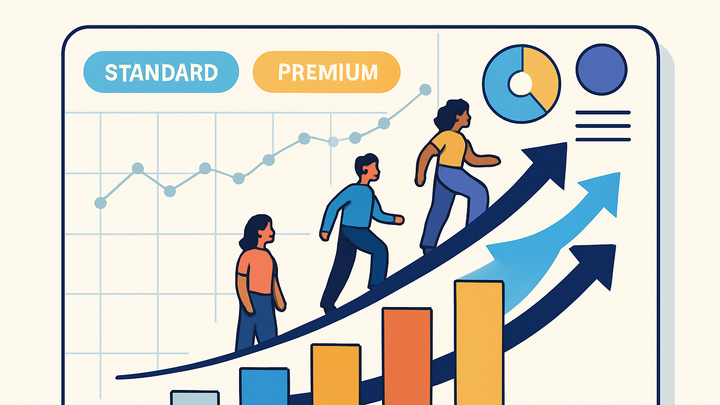Published on 2025-06-27T23:47:28Z
What is Upsell Rate? Examples of Upsell Rate in Analytics
Upsell rate is the percentage of customers who purchase an upgraded or higher-value product or service after an initial purchase. It measures a business’s success at increasing average order value and maximizing revenue from existing customers. In analytics, tracking upsell rate helps teams identify growth opportunities, evaluate sales and marketing strategies, and measure customer adoption of premium offerings. By comparing the number of customers who accept an upsell to the total number of eligible customers, businesses can gauge the effectiveness of promotions, personalized recommendations, and sales tactics. Consistently monitoring upsell rate can inform product development, pricing experiments, and personalized communication efforts to enhance customer lifetime value and revenue.
Upsell rate
Percentage of customers upgrading to a higher-tier product after an initial purchase, reflecting revenue growth potential.
Why Upsell Rate Matters
Upsell rate is a key growth metric that indicates how effectively a business increases revenue from existing customers. A high upsell rate often signals strong product-market fit, successful sales strategies, and effective personalized offers. Conversely, a low upsell rate may reveal gaps in product understanding, pricing strategy, or customer engagement. Monitoring this metric helps companies allocate resources towards initiatives that drive higher average order values and customer loyalty.
-
Revenue impact
Upselling existing customers typically costs less than acquiring new ones, making it a cost-effective way to boost overall revenue and profitability.
-
Customer lifetime value
Increasing upsell rate directly contributes to higher customer lifetime value (CLV), as customers spend more over the duration of their relationship with the business.
-
Strategic insights
Analyzing upsell trends by segment, product, or campaign uncovers insights that inform targeted marketing and product development efforts.
How to Calculate Upsell Rate
The upsell rate is calculated by dividing the number of customers who purchase an upsell by the total number of customers eligible for an upsell offer, then multiplying by 100 to express it as a percentage. Consistently tracking this metric over time reveals trends and the effectiveness of different upsell strategies.
-
Basic formula
Upsell Rate (%) = (Number of Upsell Purchases / Number of Eligible Customers) × 100
-
Example calculation
If 50 out of 1,000 eligible customers accept an upsell, the upsell rate is (50 / 1000) × 100 = 5%.
Tracking Upsell Rate with PlainSignal and GA4
Implementing tracking for upsell events can be done using various analytics platforms. Below are examples using PlainSignal (a cookie-free analytics tool) and Google Analytics 4 (GA4).
-
PlainSignal setup
To track an upsell event in PlainSignal, install the tracking script on your site and dispatch a custom event when a customer completes an upsell purchase:
<link rel="preconnect" href="//eu.plainsignal.com/" crossorigin /> <script defer data-do="yourwebsitedomain.com" data-id="0GQV1xmtzQQ" data-api="//eu.plainsignal.com" src="//cdn.plainsignal.com/plainsignal-min.js"></script> <script> PlainSignal.track('upsell_completed', { product_id: 'premium_plan', revenue: 99.99 }); </script> -
GA4 setup
In GA4, use the gtag.js or Google Tag Manager to send a custom event for upsell completions:
gtag('event', 'upsell_completed', { 'method': 'widget', 'value': 99.99, 'currency': 'USD' });
Best Practices to Improve Your Upsell Rate
Optimizing upsell rate involves personalized tactics, strategic pricing, and continuous testing. The following practices help enhance the likelihood of successful upsells.
-
Personalized recommendations
Use customer behavior and purchase history to suggest relevant upgrades or add-ons that match their needs and interests.
-
Bundling offers
Create value-packed bundles that make upgrading more attractive by offering complementary products or services at a discounted rate.
-
Timing and messaging
Test different points in the customer journey (e.g., during onboarding, post-purchase) and craft clear, benefit-focused messages for each stage.
